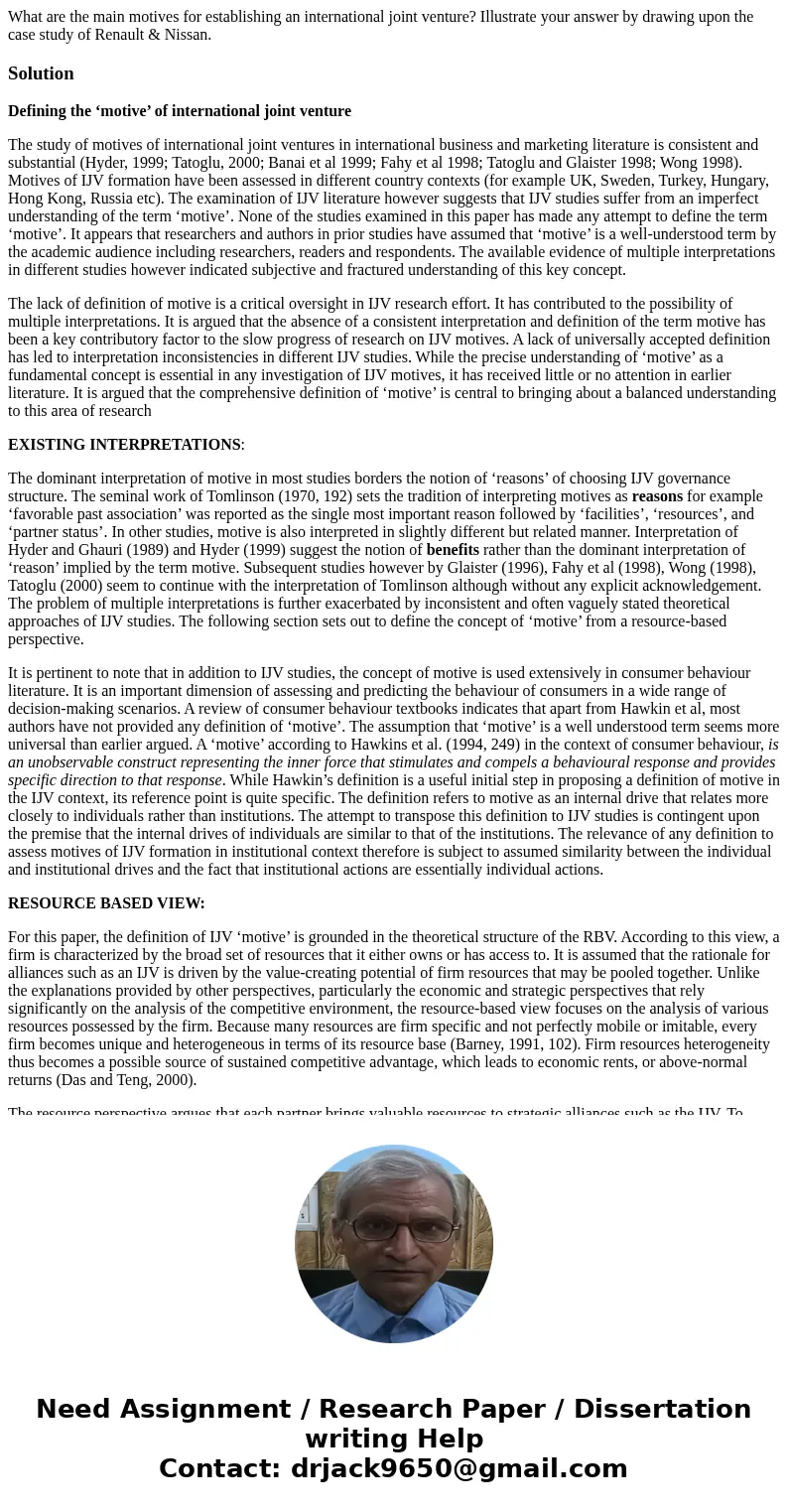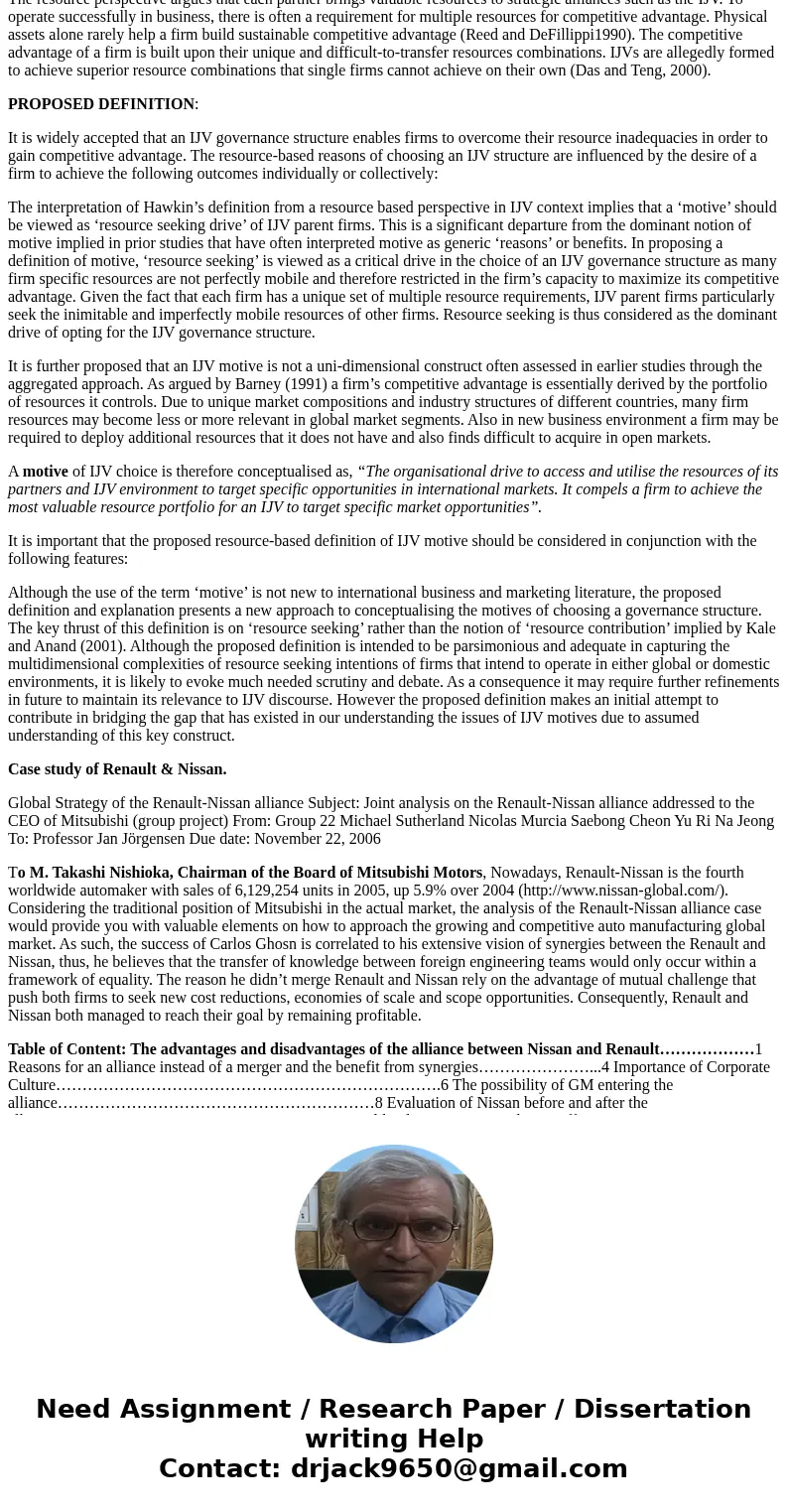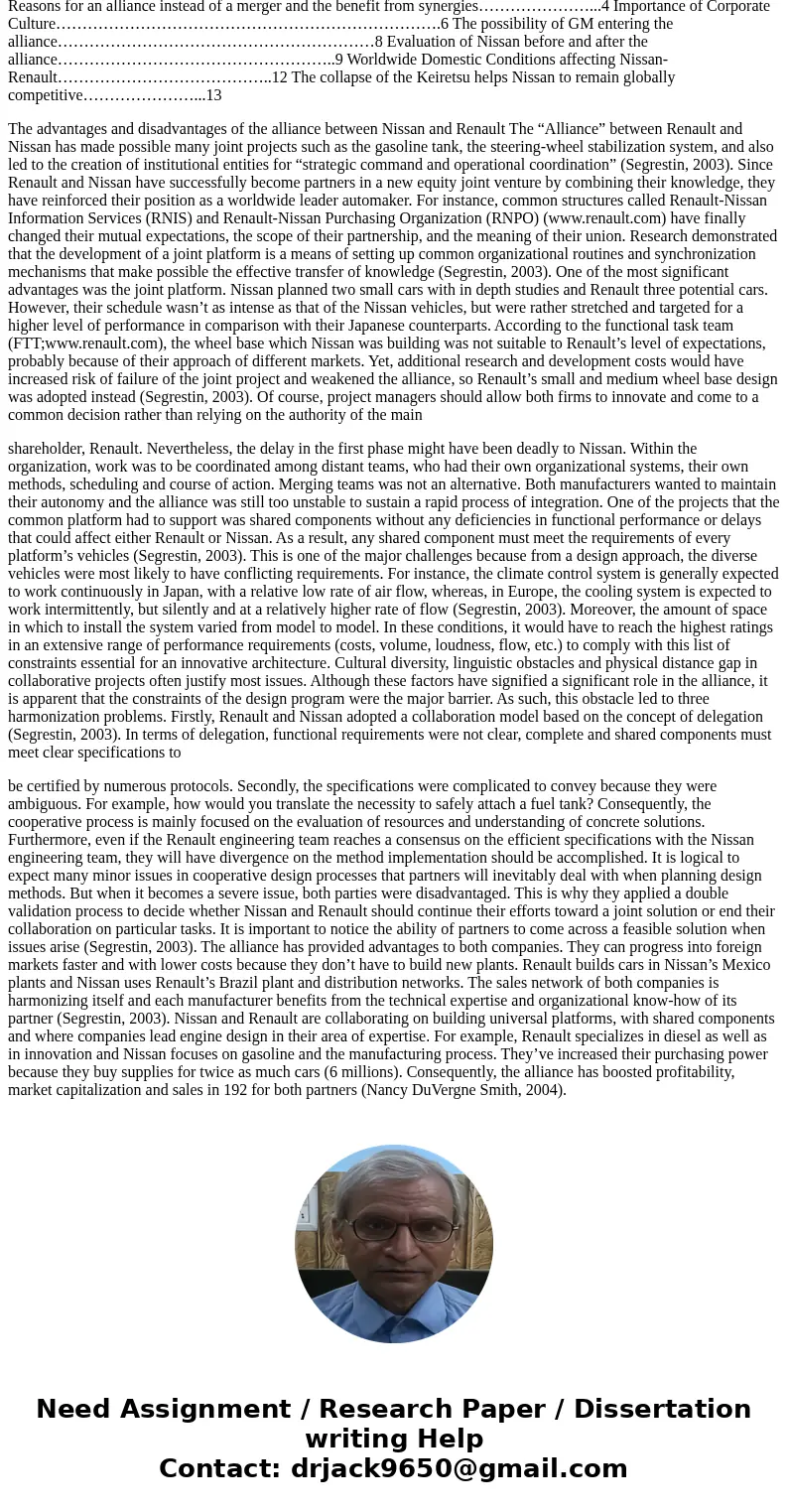What are the main motives for establishing an international
What are the main motives for establishing an international joint venture? Illustrate your answer by drawing upon the case study of Renault & Nissan.
Solution
Defining the ‘motive’ of international joint venture
The study of motives of international joint ventures in international business and marketing literature is consistent and substantial (Hyder, 1999; Tatoglu, 2000; Banai et al 1999; Fahy et al 1998; Tatoglu and Glaister 1998; Wong 1998). Motives of IJV formation have been assessed in different country contexts (for example UK, Sweden, Turkey, Hungary, Hong Kong, Russia etc). The examination of IJV literature however suggests that IJV studies suffer from an imperfect understanding of the term ‘motive’. None of the studies examined in this paper has made any attempt to define the term ‘motive’. It appears that researchers and authors in prior studies have assumed that ‘motive’ is a well-understood term by the academic audience including researchers, readers and respondents. The available evidence of multiple interpretations in different studies however indicated subjective and fractured understanding of this key concept.
The lack of definition of motive is a critical oversight in IJV research effort. It has contributed to the possibility of multiple interpretations. It is argued that the absence of a consistent interpretation and definition of the term motive has been a key contributory factor to the slow progress of research on IJV motives. A lack of universally accepted definition has led to interpretation inconsistencies in different IJV studies. While the precise understanding of ‘motive’ as a fundamental concept is essential in any investigation of IJV motives, it has received little or no attention in earlier literature. It is argued that the comprehensive definition of ‘motive’ is central to bringing about a balanced understanding to this area of research
EXISTING INTERPRETATIONS:
The dominant interpretation of motive in most studies borders the notion of ‘reasons’ of choosing IJV governance structure. The seminal work of Tomlinson (1970, 192) sets the tradition of interpreting motives as reasons for example ‘favorable past association’ was reported as the single most important reason followed by ‘facilities’, ‘resources’, and ‘partner status’. In other studies, motive is also interpreted in slightly different but related manner. Interpretation of Hyder and Ghauri (1989) and Hyder (1999) suggest the notion of benefits rather than the dominant interpretation of ‘reason’ implied by the term motive. Subsequent studies however by Glaister (1996), Fahy et al (1998), Wong (1998), Tatoglu (2000) seem to continue with the interpretation of Tomlinson although without any explicit acknowledgement. The problem of multiple interpretations is further exacerbated by inconsistent and often vaguely stated theoretical approaches of IJV studies. The following section sets out to define the concept of ‘motive’ from a resource-based perspective.
It is pertinent to note that in addition to IJV studies, the concept of motive is used extensively in consumer behaviour literature. It is an important dimension of assessing and predicting the behaviour of consumers in a wide range of decision-making scenarios. A review of consumer behaviour textbooks indicates that apart from Hawkin et al, most authors have not provided any definition of ‘motive’. The assumption that ‘motive’ is a well understood term seems more universal than earlier argued. A ‘motive’ according to Hawkins et al. (1994, 249) in the context of consumer behaviour, is an unobservable construct representing the inner force that stimulates and compels a behavioural response and provides specific direction to that response. While Hawkin’s definition is a useful initial step in proposing a definition of motive in the IJV context, its reference point is quite specific. The definition refers to motive as an internal drive that relates more closely to individuals rather than institutions. The attempt to transpose this definition to IJV studies is contingent upon the premise that the internal drives of individuals are similar to that of the institutions. The relevance of any definition to assess motives of IJV formation in institutional context therefore is subject to assumed similarity between the individual and institutional drives and the fact that institutional actions are essentially individual actions.
RESOURCE BASED VIEW:
For this paper, the definition of IJV ‘motive’ is grounded in the theoretical structure of the RBV. According to this view, a firm is characterized by the broad set of resources that it either owns or has access to. It is assumed that the rationale for alliances such as an IJV is driven by the value-creating potential of firm resources that may be pooled together. Unlike the explanations provided by other perspectives, particularly the economic and strategic perspectives that rely significantly on the analysis of the competitive environment, the resource-based view focuses on the analysis of various resources possessed by the firm. Because many resources are firm specific and not perfectly mobile or imitable, every firm becomes unique and heterogeneous in terms of its resource base (Barney, 1991, 102). Firm resources heterogeneity thus becomes a possible source of sustained competitive advantage, which leads to economic rents, or above-normal returns (Das and Teng, 2000).
The resource perspective argues that each partner brings valuable resources to strategic alliances such as the IJV. To operate successfully in business, there is often a requirement for multiple resources for competitive advantage. Physical assets alone rarely help a firm build sustainable competitive advantage (Reed and DeFillippi1990). The competitive advantage of a firm is built upon their unique and difficult-to-transfer resources combinations. IJVs are allegedly formed to achieve superior resource combinations that single firms cannot achieve on their own (Das and Teng, 2000).
PROPOSED DEFINITION:
It is widely accepted that an IJV governance structure enables firms to overcome their resource inadequacies in order to gain competitive advantage. The resource-based reasons of choosing an IJV structure are influenced by the desire of a firm to achieve the following outcomes individually or collectively:
The interpretation of Hawkin’s definition from a resource based perspective in IJV context implies that a ‘motive’ should be viewed as ‘resource seeking drive’ of IJV parent firms. This is a significant departure from the dominant notion of motive implied in prior studies that have often interpreted motive as generic ‘reasons’ or benefits. In proposing a definition of motive, ‘resource seeking’ is viewed as a critical drive in the choice of an IJV governance structure as many firm specific resources are not perfectly mobile and therefore restricted in the firm’s capacity to maximize its competitive advantage. Given the fact that each firm has a unique set of multiple resource requirements, IJV parent firms particularly seek the inimitable and imperfectly mobile resources of other firms. Resource seeking is thus considered as the dominant drive of opting for the IJV governance structure.
It is further proposed that an IJV motive is not a uni-dimensional construct often assessed in earlier studies through the aggregated approach. As argued by Barney (1991) a firm’s competitive advantage is essentially derived by the portfolio of resources it controls. Due to unique market compositions and industry structures of different countries, many firm resources may become less or more relevant in global market segments. Also in new business environment a firm may be required to deploy additional resources that it does not have and also finds difficult to acquire in open markets.
A motive of IJV choice is therefore conceptualised as, “The organisational drive to access and utilise the resources of its partners and IJV environment to target specific opportunities in international markets. It compels a firm to achieve the most valuable resource portfolio for an IJV to target specific market opportunities”.
It is important that the proposed resource-based definition of IJV motive should be considered in conjunction with the following features:
Although the use of the term ‘motive’ is not new to international business and marketing literature, the proposed definition and explanation presents a new approach to conceptualising the motives of choosing a governance structure. The key thrust of this definition is on ‘resource seeking’ rather than the notion of ‘resource contribution’ implied by Kale and Anand (2001). Although the proposed definition is intended to be parsimonious and adequate in capturing the multidimensional complexities of resource seeking intentions of firms that intend to operate in either global or domestic environments, it is likely to evoke much needed scrutiny and debate. As a consequence it may require further refinements in future to maintain its relevance to IJV discourse. However the proposed definition makes an initial attempt to contribute in bridging the gap that has existed in our understanding the issues of IJV motives due to assumed understanding of this key construct.
Case study of Renault & Nissan.
Global Strategy of the Renault-Nissan alliance Subject: Joint analysis on the Renault-Nissan alliance addressed to the CEO of Mitsubishi (group project) From: Group 22 Michael Sutherland Nicolas Murcia Saebong Cheon Yu Ri Na Jeong To: Professor Jan Jörgensen Due date: November 22, 2006
To M. Takashi Nishioka, Chairman of the Board of Mitsubishi Motors, Nowadays, Renault-Nissan is the fourth worldwide automaker with sales of 6,129,254 units in 2005, up 5.9% over 2004 (http://www.nissan-global.com/). Considering the traditional position of Mitsubishi in the actual market, the analysis of the Renault-Nissan alliance case would provide you with valuable elements on how to approach the growing and competitive auto manufacturing global market. As such, the success of Carlos Ghosn is correlated to his extensive vision of synergies between the Renault and Nissan, thus, he believes that the transfer of knowledge between foreign engineering teams would only occur within a framework of equality. The reason he didn’t merge Renault and Nissan rely on the advantage of mutual challenge that push both firms to seek new cost reductions, economies of scale and scope opportunities. Consequently, Renault and Nissan both managed to reach their goal by remaining profitable.
Table of Content: The advantages and disadvantages of the alliance between Nissan and Renault………………1 Reasons for an alliance instead of a merger and the benefit from synergies…………………...4 Importance of Corporate Culture……………………………………………………………….6 The possibility of GM entering the alliance……………………………………………………8 Evaluation of Nissan before and after the alliance……………………………………………..9 Worldwide Domestic Conditions affecting Nissan-Renault…………………………………..12 The collapse of the Keiretsu helps Nissan to remain globally competitive…………………...13
The advantages and disadvantages of the alliance between Nissan and Renault The “Alliance” between Renault and Nissan has made possible many joint projects such as the gasoline tank, the steering-wheel stabilization system, and also led to the creation of institutional entities for “strategic command and operational coordination” (Segrestin, 2003). Since Renault and Nissan have successfully become partners in a new equity joint venture by combining their knowledge, they have reinforced their position as a worldwide leader automaker. For instance, common structures called Renault-Nissan Information Services (RNIS) and Renault-Nissan Purchasing Organization (RNPO) (www.renault.com) have finally changed their mutual expectations, the scope of their partnership, and the meaning of their union. Research demonstrated that the development of a joint platform is a means of setting up common organizational routines and synchronization mechanisms that make possible the effective transfer of knowledge (Segrestin, 2003). One of the most significant advantages was the joint platform. Nissan planned two small cars with in depth studies and Renault three potential cars. However, their schedule wasn’t as intense as that of the Nissan vehicles, but were rather stretched and targeted for a higher level of performance in comparison with their Japanese counterparts. According to the functional task team (FTT;www.renault.com), the wheel base which Nissan was building was not suitable to Renault’s level of expectations, probably because of their approach of different markets. Yet, additional research and development costs would have increased risk of failure of the joint project and weakened the alliance, so Renault’s small and medium wheel base design was adopted instead (Segrestin, 2003). Of course, project managers should allow both firms to innovate and come to a common decision rather than relying on the authority of the main
shareholder, Renault. Nevertheless, the delay in the first phase might have been deadly to Nissan. Within the organization, work was to be coordinated among distant teams, who had their own organizational systems, their own methods, scheduling and course of action. Merging teams was not an alternative. Both manufacturers wanted to maintain their autonomy and the alliance was still too unstable to sustain a rapid process of integration. One of the projects that the common platform had to support was shared components without any deficiencies in functional performance or delays that could affect either Renault or Nissan. As a result, any shared component must meet the requirements of every platform’s vehicles (Segrestin, 2003). This is one of the major challenges because from a design approach, the diverse vehicles were most likely to have conflicting requirements. For instance, the climate control system is generally expected to work continuously in Japan, with a relative low rate of air flow, whereas, in Europe, the cooling system is expected to work intermittently, but silently and at a relatively higher rate of flow (Segrestin, 2003). Moreover, the amount of space in which to install the system varied from model to model. In these conditions, it would have to reach the highest ratings in an extensive range of performance requirements (costs, volume, loudness, flow, etc.) to comply with this list of constraints essential for an innovative architecture. Cultural diversity, linguistic obstacles and physical distance gap in collaborative projects often justify most issues. Although these factors have signified a significant role in the alliance, it is apparent that the constraints of the design program were the major barrier. As such, this obstacle led to three harmonization problems. Firstly, Renault and Nissan adopted a collaboration model based on the concept of delegation (Segrestin, 2003). In terms of delegation, functional requirements were not clear, complete and shared components must meet clear specifications to
be certified by numerous protocols. Secondly, the specifications were complicated to convey because they were ambiguous. For example, how would you translate the necessity to safely attach a fuel tank? Consequently, the cooperative process is mainly focused on the evaluation of resources and understanding of concrete solutions. Furthermore, even if the Renault engineering team reaches a consensus on the efficient specifications with the Nissan engineering team, they will have divergence on the method implementation should be accomplished. It is logical to expect many minor issues in cooperative design processes that partners will inevitably deal with when planning design methods. But when it becomes a severe issue, both parties were disadvantaged. This is why they applied a double validation process to decide whether Nissan and Renault should continue their efforts toward a joint solution or end their collaboration on particular tasks. It is important to notice the ability of partners to come across a feasible solution when issues arise (Segrestin, 2003). The alliance has provided advantages to both companies. They can progress into foreign markets faster and with lower costs because they don’t have to build new plants. Renault builds cars in Nissan’s Mexico plants and Nissan uses Renault’s Brazil plant and distribution networks. The sales network of both companies is harmonizing itself and each manufacturer benefits from the technical expertise and organizational know-how of its partner (Segrestin, 2003). Nissan and Renault are collaborating on building universal platforms, with shared components and where companies lead engine design in their area of expertise. For example, Renault specializes in diesel as well as in innovation and Nissan focuses on gasoline and the manufacturing process. They’ve increased their purchasing power because they buy supplies for twice as much cars (6 millions). Consequently, the alliance has boosted profitability, market capitalization and sales in 192 for both partners (Nancy DuVergne Smith, 2004).



 Homework Sourse
Homework Sourse